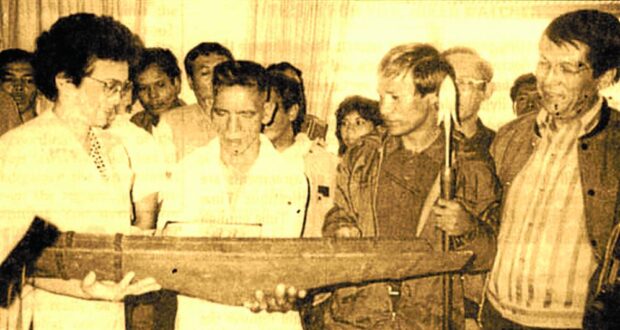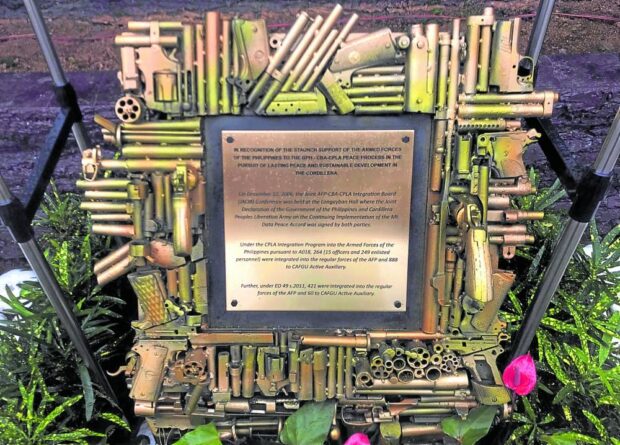Peace marker honors ‘sipat’ in Cordillera

EXCHANGE OF TOKENS In this 1986 newspaper clipping, then President Corazon Aquino (left) receives a shield and a spear as peace tokens from Ama Mario Yag-Ao of the Cordillera Bodong
Administration and rebel priest Conrado Balweg of the Cordillera People’s Liberation Army. Then Defense Secretary Juan Ponce Enrile (right) witnessed the event. —INQUIRER FILE PHOTO
FORT DEL PILAR, BAGUIO CITY — A marker, framed by gun parts broken off from 339 weapons surrendered by a decommissioned militia, now stands at the Philippine Military Academy (PMA) to honor the first formal ceasefire made after the bloodless 1986 People Power revolution.
It represents the role that the military played in establishing peace in the Cordillera, which commemorated on Wednesday the indigenous “sipat” (cessation of hostilities) between the late former President Corazon Aquino and slain rebel priest Conrado Balweg 37 years ago at Mount Data Hotel in Bauko, Mountain Province, said Army Lt. Gen. Rowen Tolentino, PMA superintendent, during the marker’s launching ceremony on Tuesday.
Sipat is a Kalinga peace treaty that was forged when Aquino gifted Balweg’s militia, the Cordillera People’s Liberation Army (CPLA), with a bible, a rosary, and an assault rifle from the military. The CPLA, in turn, gifted her with a spear and a shield as a token of trust and peace-building.
The peace pact allowed the government to begin formal negotiations with Balweg, who fought the regime of strongman Ferdinand Marcos Sr., leading to the formation of Baguio City and the provinces of Benguet, Ifugao, Mountain Province, Apayao, Abra and Kalinga into an administrative region through Executive Order No. 220 in July 1987.
The talks wound up with a closing agreement in 2011 under the administration of then President Benigno Aquino III, Aquino’s son.
Article continues after this advertisementSipat is proof of “the power of dialogue and understanding in resolving conflicts,” said Baguio Mayor Benjamin Magalong, a PMA graduate and chair of the Cordillera Peace and Order Council.
Article continues after this advertisement“Peace is not the absence of conflict but the presence of justice and understanding,” he stressed after the marker was unveiled.
The marker also advocates a new instruction to the country’s military from their commander in chief, President Marcos, which requires “soldiers to be peacemakers,” said Secretary Carlito Galvez Jr., the presidential peace adviser and a former defense chief.
Galvez graced the PMA event on Tuesday and the sipat anniversary program at Mt. Data the day after.
“Our core competency is still war fighting, but at the end of the day, we cannot ignore our ultimate objective, [which] is to attain peace,” Tolentino said.

ENDURING SYMBOL “Triggers for peace” is how a retired military general describes in jest a new peace marker at the Philippine Military Academy which honors the military’s role in securing peace in the Cordillera. Launched on the eve of the 37th anniversary of the Sept. 13, 1986, “sipat” (cessation of hostilities) between then President Corazon Aquino and rebel priest Conrado Balweg after the Edsa revolt, the marker is framed with broken parts of weapons, including two protruding handguns with triggers. —VINCENT CABREZA
Unique features
Galvez said the marker was made from weapons turned over in 2020 by Arsenio Humiding, who signed the closure agreement as CPLA chair.
Two handguns protruding from each side of the marker and triggers that could be pulled were unique features of the marker.
It was dedicated to the integration of qualified militiamen into the Armed Forces of the Philippines and other uniformed services following a Dec. 12, 2006, meeting held at PMA’s Longayban Hall by a joint integration board composed of the AFP, CPLA and its political arm, the Cordillera Bodong Administration.
The Army designated 15 officers and 249 enlisted personnel from the CPLA, while 888 of them were absorbed as active auxiliary members of the Citizens Armed Forces Geographic Unit. The military again integrated 421 CPLA members in 2011.
Autonomy
The government is reviewing commitments made by both the government and the CPLA in the course of the talks to determine what else needs to be fulfilled, said Galvez.
The Office of the Presidential Adviser on Peace, Reconciliation and Unity, he said, is seeking P711 million in the draft 2024 General Appropriations Act to provide health, education, and livelihood aid to CPLA families, and additional funds to put up a Peace and Development Center in Baguio City.
However, the government has yet to fulfill its promise to turn the Cordillera into an autonomous region like Muslim Mindanao. Cordillera autonomy is mandated by the 1987 Constitution. Section 15, Article X of the Charter states: “There shall be created autonomous regions in Muslim Mindanao and in the Cordilleras consisting of provinces, cities, municipalities, and geographical areas sharing common and distinctive historical and cultural heritage and economic and social structures.”
Two Cordillera autonomy laws, however, were rejected in plebiscites held in 1990 and 1998.
The government, Galvez said, is supporting all Cordillera efforts to become autonomous, including House Bill No. 3287 and Senate Bill No. 2275, which are the latest Cordillera autonomy measures.
HB 3267 directs the government to allocate a “block grant” for Cordillera autonomy for 10 years totaling P75 billion.
RELATED STORIES
People Power did not just happen at Edsa